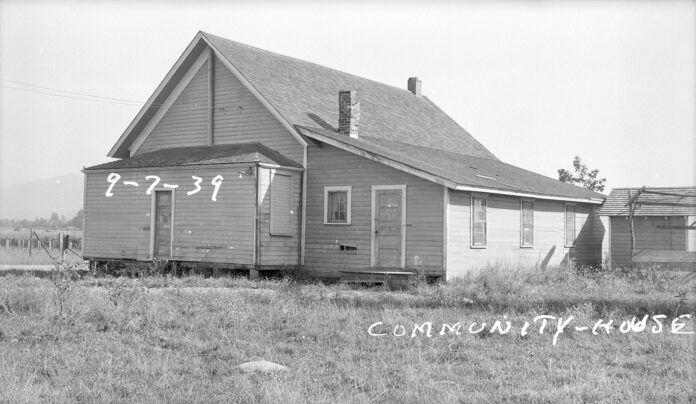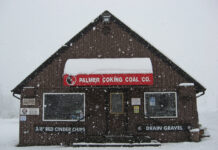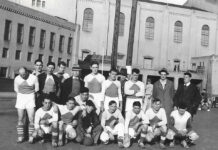For most families, Labor Day marks the traditional end of summer and the beginning of another school year. The story of the first school on the Enumclaw Plateau began 150 years ago. This was two decades after Allen Porter established a homestead on half a section of land, soon called Porter’s Prairie. Allen Porter was only 19 years old when he trekked west in 1850 with his family on the Oregon Trail. Oxen pulled their wagon.
After three years of jobs and adventure, Porter filed a land claim for 320 acres. He became the first White settler on the vast plateau that stretches from the White River near Auburn to the foothills of the Cascades. Porter constructed a log cabin and planted oats and potatoes. During the 1855-56 Indian Wars, Porter was driven off his estate by Native Americans. After the fighting died down, he returned to his property and found that his barn, wagon, and oxen had survived.
Porter left and returned several times between 1856 and 1870 to prove his claim, but it was not until 1877 that he finally gained full and legal ownership of the land. Porter’s homestead was in Section 29 on 196th Ave. S.E., two miles south of where the Auburn-Enumclaw Highway (SR-164) makes a distinctive turn to the north.
In 1875, Edwin White built a house on Porter’s Prairie. Three miles east, James & Marion Johnson settled in Boise Creek, another burgeoning community. Their children, and others, began school in the nearby home of Manifred Hicks, where Edwin & Sara White were staying. Mrs. White taught her students in the Hicks family’s living room.
It was the Plateau’s first school, founded a decade before the name Enumclaw was coined for the Northern Pacific Railway station around which the town grew to prosperity. The first students were George Vanderbeck, Amanda White, Zina & Frank Smith, and Matilda & Haveleck Johnson. The following year, more students joined – James & Marion Montgomery, from Enumclaw, Charlie Johnson, Della & Ruby Poole, George Edgar, Emma & Clyde Cuyle, and Maggie, Nellie, & Walter Murphy.
By 1877, the community was growing, and the name Osceola was used for the establishment of its post office. Today, there are dozens of places in the U.S. named for the influential leader of the Seminole tribe in Florida, who in 1838 died a martyr in a federal prison. The following year, the Osceola School District was formed, and the school moved into a tiny split-cedar shack, a picture of which is held in the University of Washington archives. That tiny, shake-roofed schoolhouse was near the future location of the Osceola pickle factory. Silas Smith, Mrs. White’s brother, was its first teacher. School lasted only three months because the trails were so bad in winter, and pupils were needed at home on the farm.
The second Osceola school, seen here on Sept. 7, 1939, was erected in 1890, one-quarter mile west of the first. The original structure was 1,000 square feet in size, measuring 25 feet by 40 feet. Porches and the lean-to added another 800 square feet, but were probably added later. It was a one-room school with students from grades one through eight. Louie Smith donated the quarter-acre of land, with a stipulation that the property would always be used for educational purposes. His son, Charles L. Smith, was later the Mayor of Seattle, from 1934 to 36.
According to Emma Ekman, whose family arrived in Osceola from Sweden in 1892, “The teachers at Osceola school always tried to get a place to board near the school so they wouldn’t have to walk too far, as they, of course, had to do the sweeping and make the fire in preparation for the day’s session.” In those days, teachers were typically paid $30 to $40 per month but generally enjoyed free room and board with host families who desired the extra education and culture absorbed by their family, at a time when literacy was far less common.
The Osceola School District No. 19 was consolidated into Enumclaw schools in 1937. After this structure was decommissioned as a school, the property was acquired by the Osceola Community Club, which used it for decades. It was then gifted to the Plateau Community Players, who used it for theatrical performances and local events. The Players sold it to Alvin & Lisa Mierke in 2017, who live next door in the third Osceola schoolhouse. This building still stands today at 45623 – 220th Ave. S.E. Next week’s column will tell the history of the Mierke home, Osceola’s third school building.
On a personal note, this columnist’s grandmother, Nina Marie Morris, plus two great aunts, Lena (Morris) Thompson and Ruth (Morris) Forest, grew up in Osceola and attended this school in the late 1890s and early 1900s. Because Enumclaw had no high school, they went to Buckley and boarded there, coming home across the White River railroad trestle only on weekends. All three attended Normal College and became teachers in surrounding communities until they married and were no longer eligible to teach. Lena (Morris) Thompson later held classes for immigrants to learn English and history to pass their citizenship tests.
This short account of Osceola’s early years is indebted to Nancy Irene Hall’s “In the Shadow of the Mountain” (1983); “There Is Only One Enumclaw” (1995) by Louise Poppleton; “The Pioneer History of Enumclaw” (1941), compiled by the Women’s Progressive Club; and John Anderson’s “A History of Enumclaw’s Schools” (2013). This King County Assessor photo of tax lot 282006-9041 comes courtesy of the Puget Sound Regional Archives. Photo enhancements were undertaken by Boomer Burnham, a Tahoma High School photography instructor, doing business as http://www.boomersphotography.com/







